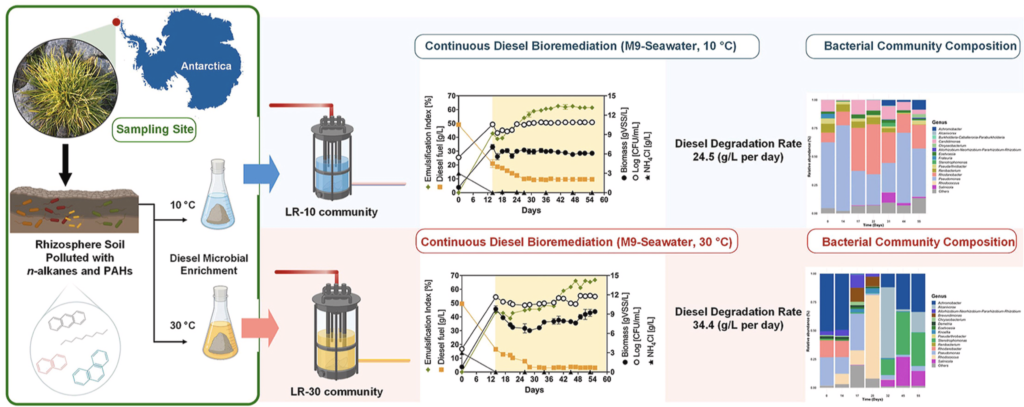Continuous bioreactors enable high-level bioremediation of diesel-contaminated seawater at low and mesophilic temperatures using Antarctic bacterial consortia: Pollutant analysis and microbial community composition

In 2020, more than 21,000 tons of diesel oil were released accidently into the environment with most of it contaminating water bodies. There is an urgent need for sustainable technologies to clean up rivers and oceans to protect wildlife and human health. One solution is harnessing the power of bacterial consortia; however isolated microbes from different environments have shown low diesel bioremediation rates in seawater thus far. An outstanding question is whether Antarctic microorganisms that thrive in environments polluted with hydrocarbons exhibit better diesel degrading activities when propagated at higher temperatures than those encountered in their natural ecosystems.
Here, we isolated bacterial consortia, LR-30 (30 °C) and LR-10 (10 °C), from the Antarctic rhizosphere soil of Deschampsia antarctica (Livingston Island), that used diesel oil as the only carbon substrate. We found that LR-30 and LR-10 batch bioreactors metabolized nearly the entire diesel content when the initial concentration was 10 (g/L) in seawater. Increasing the initial diesel concentration to 50 gDiesel/L, LR-30 and LR-10 bioconverted 33.4 and 31.2 gDiesel/L in 7 days, respectively. The 16S rRNA gene sequencing profiles revealed that the dominant bacterial genera of the inoculated LR-30 community were Achromobacter (50.6%), Pseudomonas (25%) and Rhodanobacter (14.9%), whereas for LR-10 were Pseudomonas (58%), Candidimonas (10.3%) and Renibacterium (7.8%). We also established continuous bioreactors for diesel biodegradation where LR-30 bioremediated diesel at an unprecedent rate of (34.4 g/L per day), while LR-10 achieved (24.5 g/L per day) at 10 °C for one month. The abundance of each bacterial genera present significantly fluctuated at some point during the diesel bioremediation process, yet Achromobacter and Pseudomonas were the most abundant member at the end of the batch and continuous bioreactors for LR-30 and LR-10, respectively.
Manuscript could be downloaded here